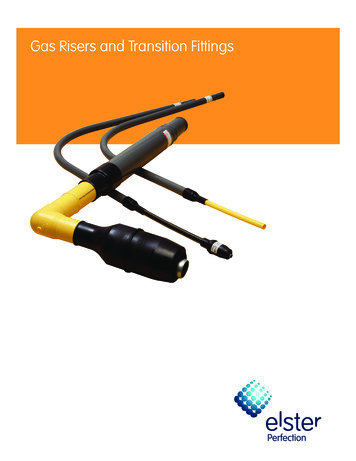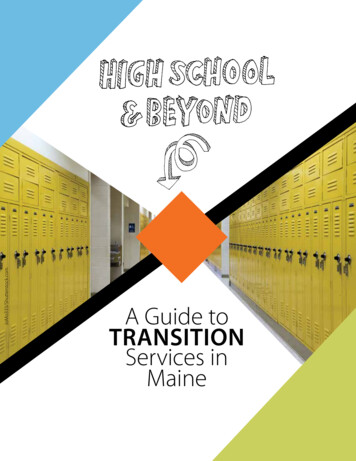
Transcription
AcceleratingTransitionEconomic Impacts of IndigenousLeadership in Catalyzing the Transitionto a Clean Energy Future Across CanadaINDIGENOUSCLE AN ENERGY428 Gilmour StreetOttawa, ON K2P 0R8 CANADAe info@indigenouscleanenergy.comt mCLE AN ENERGY
Accelerating TransitionEconomic Impacts of Indigenous Leadership in Catalyzingthe Transition to a Clean Energy Future Across CanadaJUNE 2020Indigenous Clean Energy (ICE) Social Enterpriseis an independent, Indigenous-governed, nonprofit organization. ICE advances Indigenousand broader sustainable prosperity bysupporting First Nation, Métis, and Inuit cleanenergy participation in every region of Canada.This survey draws on ICE’s national researchdatabase of Indigenous clean energy projectswhich has been maintained for over 10 years.2Accelerating TransitionPrimary Contacts:Chris Hendersonchenderson@indigenouscleanenergy.comTerri Lynn Morrisontlmorrison@indigenouscleanenergy.comLead Researcher:Cara SandersAskii EnvironmentalFind out more:indigenouscleanenergy.comINDIGENOUSCLE AN ENERGY
The ‘Sweetgrass’ of IndigenousClean EnergyIn her spellbinding book Braiding Sweetgrass, RobinWall Kimmerer of the Potawatomi Nation writesof how her “braid of stories is woven from threestrands: Indigenous ways of knowing, scientificknowledge, and the story of an Anishinabekscientist.” She goes further and expresses that“wiingashk, or sweetgrass is a powerful ceremonialplant cherished by many Indigenous nations itsvalue both material and spiritual.”In this same fashion, as Indigenous peoples playa more and more vital role in the development ofclean energy projects in every province and territoryof Canada, new stories are being woven. They aredemonstrating how a unique Indigenous-centeredapproach can realize a braid of impacts withstrands of cultural, economic, and environmentalprominence.This is about embracing a new way of being. It is notsimply the case of moving with pace to a clean energyfuture – it is about a Just Transition. An end pointwhere how we create and use energy embodies:» Adherence to Indigenous rights and treaties, thenorms of free, prior, and informed consent, andthe United Nations Declaration on the Rights ofIndigenous Peoples;» Respect for all ancestral Lands and Waters of FirstNation, Métis, and Inuit communities, withoutexception, across Canada; and,powerful force for change in the country’s transitionto a clean energy future. The numbers presented inthis survey are truly staggering. Apart from crownand private utilities, Indigenous communitiesand enterprises are the largest single owner ofclean energy assets. It would be fair to describeIndigenous people as the country’s strongest cleanenergy community, and Indigenous Clean Energy(ICE) as Canada’s National Partnership Hub advancingFirst Nation, Métis, and Inuit clean energy projects.We at ICE, believe the evidence is definitive –Indigenous leadership is essential to the realizationof the Sustainable Development Goals (SDGs) inCanada, and our country’s economic development,clean energy future, and reconciliation withIndigenous peoples.Darrell BrownChair, Board of DirectorsChris HendersonExecutive Director» Intention to realize a diverse array of social andeconomic outcomes for Indigenous communitiesand peoples, and their partners, with profoundaction on Climate.Indigenous communities across Canada are aINDIGENOUSCLE AN ENERGYAccelerating Transition3
Trends & Highlights» Indigenous clean energy projects continueto ramp up Canada-wide. A larger number ofdiverse projects are coming online across thespectrum of renewables, energy efficiency, andadvanced technologies.» A total of 197 medium-to-large renewableenergy generating projects with Indigenousinvolvement are now in operation (171projects) or in the final stages of planning orconstruction (26 projects). Most of these projectsinvolve partnerships between Indigenouscommunities and energy sector companies,utilities, or developers.» Medium-to-large Indigenous renewable energyprojects have experienced a 29.6% growth rateacross Canada since 2017.» The energy sources for medium-to-large scaleprojects include: Hydro (56.5%), Wind (22.9%),Solar (11.8%), Bioenergy (7.1%), and HybridSources (1.7%).» Renewable energy projects to replace dieselreliant generation of heat and power arebecoming very prevalent across Canada, inlarge measure due to government programmingsuch as NRCan’s Clean Energy for Rural and RemoteCommunities (CERRC). Many of these are microgrids integrating renewable power generationwith battery storage and control systems to tieinto local power plants. Almost all these projectsare in development and will be operationalover the next 1-3 years and are therefore not yetaccounted for in projects completed or in latterstages of development in this report.» Indigenous involvement in electricity transmissionis growing. Nineteen (19) projects are completedor in construction. These projects involve: gridaccess for major projects (e.g. La Romaine Hydro,» Smaller Indigenous clean energy projects areproliferating with many Indigenous communitiesinstalling community-scale or small-generationsolar systems supplying provincial/territorial grids.It is estimated that 1,700 – 2,100 micro or smallrenewable energy systems are now in placewith Indigenous leadership/partnerships. A highproportion (just under 50%) of these installationsare in Ontario.» Bioenergy projects have boomed. Some 72 powerand/or heat generating systems are nowfunctioning, or about to be switched on. Most ofthese projects are of modest scale, though four (4) areincluded in the set of medium-to-large renewableenergy projects. Some of these projects (5 in total)employ Geothermal or Earth Energy technologies.Culture and energy infrastructure mix at the Okikendawt Hydro Project owned by theDokis First Nation in partnership with Hydromega.4Accelerating TransitionINDIGENOUSCLE AN ENERGY
Quebec), off-grid community interconnection(e.g. Wataynikaneyap Power, Ontario) or gridstrengthening (e.g. Bipole III, Manitoba). Four (4)of these projects are necessary interconnectionsfor medium-to-large generating projects. Theremaining projects, which are strictly transmissionfocused, represent major infrastructure investment,but are not included in the list of medium-to-largerenewable energy projects.» An independent survey has identified aminimum of 127 energy efficiency projectsin Indigenous communities at various stages ofimplementation, from early stage planning tocompletion. Most of these are small-scale orpilot projects, and many involve energy auditsand retrofits.» The level of Indigenous ownership of cleanenergy projects appears to slot into one of threemodels: 1) Minor project participation reflective ofsingle digit ownership percentages, or equivalentfinancial benefit; 2) Significant minority ownershipwhich is trending towards 25-50% projectparticipation; and 3) 100% Indigenous communityownership, which is becoming more common incomparison to three years ago.development risk continue to be central toIndigenous clean energy action, and the roleof provinces and territories is critical. There areopportunities, for example, to promote largescale clean energy procurement (e.g. Albertaand Saskatchewan), or to kick start off-griddiesel-replacement projects (Yukon).» Most Indigenous clean energy projects haveincluded specific measures to optimize thereduction of Greenhouse Gases (GHGs). Giventhe long lifecycle of projects, their carbon valuewill increase as carbon levies/fees rise.» Community energy planning is an importantcatalyst that garners Indigenous and local supportfor clean energy projects and partnerships.Such engagement and educational effortsare a hallmark of successfully implementedIndigenous clean energy projects.» Communities are already looking aheadat future clean energy opportunities. Thissurvey includes an analysis of what’s on thehorizon with Indigenous clean energy includingenergy efficient housing and infrastructure,advanced energy, and broad-based, low-carbonelectrification.» The impact on employment and contractingincome from Indigenous clean energy projects isgame-changing. While medium-to-large renewableenergy projects are significant job-creators duringconstruction, operational employment is quitemodest. However, micro-small and transmissionprojects are catalyzing both construction andoperational employment. The major clean energyjob creators, though, are bioenergy and energyefficiency projects which have long-term andsustained economic multiplier effects.» Government policies and programs, includingelectricity procurement mechanisms, andfunding arrangements which reduce projectINDIGENOUSCLE AN ENERGYWind Turbine Blades for the Tobique Wind Project at Port of St. John, NBAccelerating Transition5
Cross Canada PictureThe footprint of Indigenous clean energy projectparticipation is nation-wide, with every jurisdictionpromoting some manner of policy, regulation,procurement regime, or support programs. Thepiechart to theright highlightsthe distributionofProvincial& TerritorialDistributionof s provinces and territories.Provincial & Territorial Distribution of Medium-LargeIndigenous Renewable Energy ProjectsNUNLPEBCNBNTMBSKNLBC, Ontario, and Quebec are the top threePEBCjurisdictionsin terms of number of medium-largeNBNTIndigenousrenewable power projects. This is in largeMBmeasuredue to provincial policies and procurementSKprogramsYK for independent power production (IPP)ABwhich gave value to Indigenous participation. It isQC partnerships betweenalso theNSresult of proactiveON andproject development firms and utilities,Indigenous communities.YKABNSQCONpower offtake (i.e. Power Purchase Agreements orElectricity Purchase Contracts) arrangements.It is also important to note that the project trackingrepresented in these two charts is for mediumto-large renewable generating projects. The largenumber of micro-small renewable energy, remotecommunity diesel reduction, bioenergy, andProjectCompletionTimeline fortransmissionprojectsadd significantlyto Medium-Large IndigenouThe chart below tracks when medium-to-largeIndigenous clean energy projects were or areprojected for commissioning. The peak period, sofar, was between 2013-2016. However, the chart alsoshows that the downturn during 2018-2019 was shortlived, and there is a huge wave of projects in the finalstages of planning or construction, many with securedIndigenous clean energy projects totals.Number of projects353025Project Completion Timeline for Medium-Large IndigenousRenewable Energy Projects6Accelerating 200920082007200620052004200320022001PRE 200002012201120102009200820072006Start Date of Project 0013015PRE 2000Number of projects3520Start Date of Project OperationsINDIGENOUSCLE AN ENERGY
20/20 Catalysts viewing Atlin Lake, BCBenchmarkingIndigenous CleanEnergy ProjectsIn total there are 2,107–2,507 Indigenous clean energyprojects encompassing power generation, electricitytransmission, heat production, and energy efficiency. Theseprojects span across Canada and are currently operational,or in the final stages of development. Indigenousparticipation in these projects may include: Indigenousownership/co-ownership; stipulated economic benefits;royalty agreements; Indigenous financing; revenue sharingagreements; lease agreements; Impact Benefit Agreements(IBA’s); and/or partnership agreements.The scale of Indigenous clean energy leadership andownership will continue to grow significantly overthe short and longer-term. This growth will increaseemployment and economic development for First Nation,Métis, and Inuit communities, and Canada more broadly.Here’s how the numbers are adding up with Indigenousclean energy project participation and outcomes.INDIGENOUSCLE AN ENERGYMethodology NotesProjects and Indigenous ownershipmetrics have been validated byempirical data. Return, employmentand contracting projections arebased on highly conservativeassumptions backstopped byempirical data. Projections are basedon projects completed or in the finalstages of development. Projectionsdo not include the potentialeconomic and employmentimpacts for projects at early stagesof development, or yet to beconsidered. Projections are strictlyfor direct project impacts. There arecertainly additional multiplier effectsthat have not been included here,notably in terms of: i) economic andsocial re-investment of clean energyproject earnings, ii) economicactivity resulting from expendituresof employment and contractingincome, and iii) household andcommunity cost savings attributableto energy efficiency infrastructureand advanced technologies.Accelerating Transition7
INDIGENOUS CLEAN ENERGY2107–2507 PROJECTS IN TOTAL1971700–2100Medium to LargeRenewable Energy Projects127Energy EfficientHomes45%32%Trend inAverage IndigenousOwnership 1.492 billionEstimated 10 yearIndigenous Employment& Contracting Income 295 millionSmall RenewableEnergy 9,135Person Years ofConstruction Employment2,870Person Years of OperatingEmployment AnnuallyEstimated net AnnualReturns from AllProjects 2020ECONOMIC IMPACTS8Accelerating TransitionEMPLOYMENT IMPACTS
Diesel ReductionArctic ActionFort ChipewyanInukjuakBioenergy InnovationMeadow LakeCommunity PowerHealthy LivingTsilhqot’inJames BayEconomic DevelopmentStirlingClimate ChangeTobiqueJob CreationHenvey InletThe 300MV Henvey Inlet Wind Project. Photo credit: Henvey Inlet WindProject, Henvey Inlet First Nation.Six illustrative examples of the over 2000 Indigenous clean energy projects across Canada.Incredible Impacts – Projects in ProfileClean energy is a game changer for Indigenouscommunities. Each project delivers a set of outcomesthat express the Sustainable Development Goals(SDGs) through the realization of social, economic,and environmental benefits – for the community,their regions, provinces or territories, and Canada.Here are some awesome Projects in Profile.Diesel ReductionThree Nations Energy (3NE) is a unique partnershipbetween Athabasca Chipewyan First Nation, MikisewCree First Nation, and Métis Local 125 which willown and operate a solar photovoltaic system of7,500 panels that will replace 800,000 litres of dieselfuel each year in Fort Chipewyan, Alberta. Slatedfor construction in 2020, 3NE will foster a climatefriendly economy that is less dependent on dieseltanker trucks. Power generated will be sold to thelocal utility which is operated by ATCO.Job CreationHenvey Inlet First Nation Wind in Ontario is a uniquepartnership between Nigig Power Corporation, anentity of the Henvey Inlet First Nation and PatternCanada. As one of Canada’s largest wind farms at300 megawatts, the project has or is, creating over1,000 new jobs in the Georgian Bay area during peakconstruction; more than 20 permanent jobs duringoperations; and, over 100 indirect jobs throughexpansion of programs and services of the HenveyInlet Band.Solar panels installed in the first phase of the Three Nations Energy solar project.Photo credit: Donald Voyageur, Journal of CommerceINDIGENOUSCLE AN ENERGYAccelerating Transition9
Incredible Impacts – Projects in ProfileBioenergy InnovationThe Meadow Lake Tribal Council in Saskatchewanis building a bioenergy plant using an OrganicRankin Cycle technology supplied by Turboden ofItaly which will generate electricity from biomassfuel derived from residual wood waste andproduce 6,600kW (net) of carbon neutral baseloadelectricity to power approximately 5,000 homes.The cogeneration system will also provide heat tothe NorSask sawmill buildings and a high efficiencylumber dry kiln, reducing natural gas consumptionand improving the economics of Canada’s largest100% Indigenous-owned sawmill facility.Meadow Lake Tribal Council set to construct an Organic Rankin Cycle facility like the onepictured her. Photo credit: Meadow Lake Tribal Council Bioenergy Centre.Arctic ActionConstruction of the 10-megawatt Innavik Hydro isslated to begin soon in the diesel-reliant communityof Inukjuak, Quebec. The project is being developedthrough a partnership between the Inuit PituvikLandholding Corporation and Innergex RenewableEnergy Inc. The project will eliminate consumption ofalmost all diesel fuel currently consumed for powerand heating. Over the 40-year power purchaseagreement finalized with Hydro Quebec, 767,208tonnes of CO2 will be reduced.The future site of the 10MW Innavik Hydro project on the Inukjuak River.Community PowerThe Tsilhqot’in First Nation near Williams Lake, BritishColumbia has installed a small community solararray fully owned and operated by the First Nation.The two-hectare solar site is made up of 3,456 solarmodules generating electricity sold to BC Hydro. Theproject will produce approximately 1,500 megawatthours of electricity each year over the solar farm’s25-year lifespan.10Accelerating TransitionAn aerial view of the Tsilhqot’in First Nation’s solar array. Photo credit: EcoSmart.INDIGENOUSCLE AN ENERGY
Climate ChangeThe Wocawson Energy Project in New Brunswick isled by the Tobique First Nation in partnership withproject developer Natural Forces. Consisting of upto a dozen wind turbines and an installed capacitytopping out at 40 Megawatts, the project will bebuilt in two phases. The wind facility will supply some5,000 homes with electricity while offsetting 22,00044,000 tonnes of carbon dioxide annually.Workers building a platform for one of a dozen wind turbines as part of the Wocawson Windproject. Photo credit: Natural Forces.Economic DevelopmentLocal workforce adding instulations and air sealing a home on the James Bay coast. PhotoCredit: Conservation on the Coast Facebook.Healthy LivingConservation on the Coast (COTC) retrofits 10 homesper year in each of the communities of Attawapiskat,Fort Albany, and Kashechewan on the shores ofJames Bay, Ontario making them healthier, morecomfortable, and more energy efficient. To improvethe health and safety of the occupants COTC sealsair leaks and installs a membrane over the earthencrawlspace floor to stop moisture migration intothe house. A Heat Recovery Ventilator or HRV isinstalled to maintain a healthy moisture level, whichautomatically limits mould growth, and exchangesstale house air with fresh outdoor air. The work donein all communities is completed by locally trainedcommunity members, providing employment andskills upgrading.Approved through an open bid process by the AlbertaElectric System Operator (AESO), the Stirling WindProject sized at 113 Megawatts is a large economicdevelopment driver for southwestern Alberta. Theproject, a partnership with Paul First Nation, willinvolve the installation of up to 28 wind turbines, anelectrical collection system, access roads, and a newelectrical substation. The Stirling Renewable EnergyLimited Partnership, in mid-stage development, willlook to the local community wherever possible forlocal trades and other business opportunities.Mi’gmaq carpenter in the base of a wind turbine at the Mesgi’g Ugju’s’n Wind Farm Photo:www.muwindfarm.comINDIGENOUSCLE AN ENERGYAccelerating Transition11
Henvey Inlet Wind ProjectAccelerating Canada’s EnergyTransition – What’s on the Horizon“The next stage of the Canadian and global energy revolution willemphasize: further renewable energy development; enhancedenergy efficiency of homes, community facilities and industry;advanced energy systems; and green energy infrastructure. Thesedevelopments offer major economic development and climateaction opportunities for First Nations.”Preamble to Assembly of First Nations Chiefs Resolution on AdvancingFirst Nations Clean Energy Leadership for Economic Development andAction on Climate Change, July 201912Accelerating TransitionINDIGENOUSCLE AN ENERGY
Major forces are shaping the future. Firstly,Indigenous communities and enterprises arealready beginning to seize business opportunitiesthat reflect a transition process characterized bythe decarbonization and digitalization of energy.Secondly, there is a growing group of First Nation,Métis, and Inuit champions, including 20/20 Catalystsand community leadership with the skills andexperience to take projects and partnerships forward.Thirdly, Indigenous communities have a broad-basedinterest in realizing economic benefits from cleanenergy, particularly through Indigenous companies.Fourthly, First Nation, Métis, and Inuit communitiesand leaders are incredibly motivated to take actionon climate change through clean energy.Atlin Hydro penstock installation, Taku River Tlingit First Nation, BCIndigenous Clean Energy (ICE) observes that theseforces are catalyzing clean energy projects andbusinesses in major sub-sectors. These emergingopportunities are described below in order ofprojected magnitude of impact.Community-Scale Energy Efficiencyand HousingImproving housing energy efficiency in Indigenouscommunities is a massive opportunity to reduceenergy use and costs and create local jobs andinvestments, while positively impacting health andINDIGENOUSCLE AN ENERGYwell-being. Through the Bringing it Home initiative,ICE is working with first set of ‘Guide Communities’ todevelop and implement plans for community-widedeep retrofits, high performance standards for newbuilds, sourcing financial investment, and puttingmanagement/technical implementation capacity inplace. Bringing It Home is scalable nationally fromcommunities such as the Heiltsuk First Nation (BC),Fishing Lake Métis Settlement (AB), Île-à-la-Crosse(SK), Animbiigoo Zaagi’igan Anishinaabek (ON),Red Rock Indian Band (ON), and the Inuit hamletof Kugaaruk (NU) with application to hundreds ofthousands of Indigenous homes across the country.Bioenergy Lands Management,Feedstocks and Energy ConversionIntegrated bioenergy resource development offersa three-prongs of economic and carbon benefits.Firstly, enhanced lands management increasesbio-feedstock supply while also augmenting forestscarbon sequestration and reducing forest fire risk.Secondly, bio-feedstock supply creates economicopportunities for Indigenous communities andentrepreneurs. Thirdly, conversion of feedstocksthrough Combined Heat Power (CHP) andgasification systems offer a wide range of applicationsto support communities and industry to reducecosts and carbon impact. Such resources are also anessential part of the solution for advanced biofuels.Indigenous communities hold land rights andforest tenures, possess silviculture know-how, and,most importantly, represent a large, geographicallydistributed and competent labour pool to service agrowing bioenergy economy. Teslin First Nation inYukon is a leader with such bioenergy development.Hydro Facility RefurbishmentWaterpower accounts for over 60% of electricitygeneration in Canada. Almost all provinces andterritories are reliant on hydro dams and reservoirsAccelerating Transition13
industrial/commercial companies.Renewable Energy Microgridsin Diesel-Reliant CommunitiesIndigenous youth at the ICE Gathering – a key element for accelerating the transitionfor electricity supply. Between 300 and 500 of suchlegacy hydro facilities will require refurbishmentor rebuilding over the next twenty years and arelocated on First Nation, Métis, and Inuit territory andancestral lands. Upgrading hydro facilities is criticallyimportant for powering Canada’s economy; and suchinitiatives can be most effectively advanced throughIndigenous partnerships covering environmentalprotection, cultural recognition, economicdevelopment, and project participation. The AcadiaFirst Nation and Nova Scotia Power are collaboratingon such hydro facility refurbishment.‘Behind the Meter’ Renewable EnergyTechnological innovation offers industry, publicfacilities, and commercial/institutional facilitiesa means to diversify electricity supply. Rapidlydeclining costs and increasing reliability of platformssuch as solar-plus-storage systems are making‘behind the meter’ options cheaper than the costof provincial/territorial grids in certain conditions.Providing such distributed generating capacity inpartnership with major electricity consumers, is aninterest for Indigenous communities. Six Nationsof the Grand River Development Corporation isinvolved with ‘behind the meter’ projects with14Accelerating TransitionNever has there been such a confluence of interestin supporting remote and Northern Indigenouscommunities in Canada to reduce diesel reliancethrough renewable energy. Feasibility planningis underway on solar, wind, hydro, and bioenergyprojects in over 24 diesel communities. While suchprojects are challenging, and necessarily requirecollaboration with utilities, these developmentsherald a new area for renewable energy in remotecommunities, particularly in the Arctic. TheNunatsiavut Government on the North Coast ofLabrador is conducting a Front-End EngineeringDesign (FEED) study for two wind turbines to supplyclean energy to the community of Nain.Municipal PartnershipsIndigenous communities and municipalities are oftengeographic neighbours. Yet, there has been limitedcooperation on clean energy, either for renewableenergy development, or cooperative communityenergy efficiency action. This is an untapped areaof collaboration, but the situation is changing. Anearly example of such a joint venture is HupacasathFirst Nation on Vancouver Island, who worked withthe City of Port Alberni on the China Creek HydroProject. More recently, the Bayside DevelopmentCorporation owned by the Paqtnkek First Nation, andthe Municipality of the County of Antigonish in NovaScotia are partnering a ground-mounted 72-kilowatt,290 solar photo-voltaic installation located adjacentto municipal offices. Opportunities for municipalIndigenous clean cooperation in urban and built upareas holds particular promise.INDIGENOUSCLE AN ENERGY
20/20 Catalysts touring a 100MW solar project owned in partnership with Six Nations of the Grand River.District EnergyTransport ElectrificationProjects which heat and cool multi-unit residencesand/or a groups of community facilities from acentral plant is referred to as District Energy, and suchinstallations are limited across Canada, includingin Indigenous communities. However, some FirstNation, Métis and Inuit communities with accessto biomass resources, or with waste heat recoveryfrom generating plants are taking advantage of suchresources. The Oujé-Bougoumou Cree Nation inQuebec with support from the federal governmentis upgrading an existing biomass district heatingsystem, and expanding the market for local sawmillwaste, supporting local economic development andbetter waste management.Indigenous communities rely heavily on all mannerof transport, especially since many communitiesare located outside of major urban areas. The costof fuel, and associated environmental impacts, areleading communities to consider electric transportoptions. The development of electric trucks, ATV’s,snow machines, and boats is opening up greateropportunities for electrification as these machinesstart to meet the needs of community members.Indigenous communities are also beginning toramp up electric charging infrastructure. The StoneyNakoda First Nation in Alberta is now home to twonew charging stations powered by renewable energyat the Bearspaw First Nation’s Travel Centre on theTrans-Canada Highway.INDIGENOUSCLE AN ENERGYAccelerating Transition15
Clean Energy MiningEnergy StorageCanada’s mining companies are highly reliant onhydrocarbons such as diesel fuel and Liquified NaturalGas (LNG) for extracting and processing mineralresources. The sector is becoming more proactivein in seeking renewable energy options, and, sincemany mines are located in regions with Indigenouscommunities, project cooperation is emerging. Thewestern Hudson’s Bay diesel-reliant community ofRankin Inlet, Nunavut has excellent wind resources, asdoes the Agnico Eagle Mine 40 kilometers from thecommunity. Joint wind energy development couldreduce development and capital costs.Indigenous community participation in energystorage projects are at an early stage, but are beingconsidered for several applications, including: batterystorage integrated with micro grid projects, pumpedhydro storage, and grid storage systems to addresssupply bottlenecks and peaking requirements. Oneof the projects being considered to supply electricityneeds for the Yukon grid is a potential pumpedhydro storage site at Moon Lake in northern BC onthe traditional territory of the Taku River Tlingit andCarcross Tagish Nations.Simply put, the ‘Future is Now’, and Indigenouscommunities and entrepreneurs will be more andmore important players in energy diversification,technology innovation, and value-generating cleanenergy projects and ventures cross Canada.Breakout group at the 2019 ICE Gathering in Ottawa16Accelerating TransitionINDIGENOUSCLE AN ENERGY
2019 Catalysts Tour of Nanticoke Solar built on the recommissioned site of one of Canada’s largest coal plantswith partnership with Six Nations of the Grand River and the Mississaugas of the Credit First Nation.Indigenous Clean Energy —National Partnership HubIndigenous Clean Energy Social Enterprise (ICE) isan independent, Indigenous-governed non-profitorganization. In the introduction to this survey it washighlighted that an Indigenous-centered approachcan realize a braid of impacts – strands of social,economic and environmental prominence. ICE’s logoreflects this braid - the ‘sweetgrass’ of Indigenousclean energy.ICE programs are hugely collaborative. As a NationalPartnership Hub, we work with governments,corporations, foundations, clean energy companies,NGOs, educational bodies, and financial firms. Severaldozen clean energy experts, including many alumniof the 20/20 Catalysts program, and other IndigenousINDI
The 'Sweetgrass' of Indigenous Clean Energy In her spellbinding book Braiding Sweetgrass, Robin Wall Kimmerer of the Potawatomi Nation writes of how her "braid of stories is woven from three










